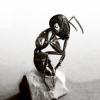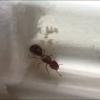I left them to hibernate in my hall way 60F (15C), in early November giving them little to no food and water every few weeks. We then moved to a new house where they were bumped around in a car and exposed to cold, then a family death, and I left them for 4 weeks with nothing in a box put away.
When I got around to checking them they had molded badly and 4 whole colonies were dead, and 8 test tube queens. I still have a couple of queens left, I gave them all food and cleaned out the formicariums to reuse, and put them on a heating cable, they all seem to be responding to the heat, moving closer. I have a Formica subsericea queen with 5 workers, three Camponotus sp. with 5+ workers, and two Lasius sp. with 3 and 4 workers. I want to move them all due to the dirty test tubes. should I wait or move them right away? and any suggestions on hibernating would be great too. Thanks.
Edited by AntsMAN, August 30 2016 - 6:49 AM.


























